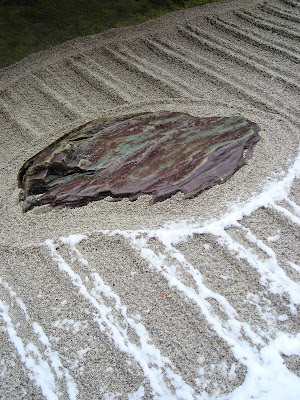30th December 2010
Thanks to an invitation from the Hoshinoya group, I was able to squeeze in one more ryokan visit before the end of the year.
Its newest property, Hoshinoya Kyoto, is tucked into the mountains of Arashiyama, an area once favoured by the city's nobles. Today, it is a popular tourist spot, especially during the sakura and autumn foliage seasons.
But what made me say yes to the invitation was the boat. Guests are ferried to the ryokan in a boat that goes up the scenic Hozugawa river. It's not quite the Three Gorges but it does have the advantage of not being dammed up.

The Hoshinoya Kyoto boat landing. Up a flight of stairs nearby is a waiting room that has magazines, coffee, a toilet with the world's smallest sink and is, above all, warm. In winter - and spring, come to think of it - this is important.

The boat pulling up to the ryokan's pier. You can go outside to take photos; presumably, fishing you out of the river if you fall in is all part of the service.
The ride's a leisurely one, giving you the time you need to photograph the sociable ducks, the grave egrets and the tourists floating by in other boats.

November is high season for the ryokan. This shot of the entrance from Hoshinoya shows you why. The inn was fully booked through the momiji season, so I didn't get to see this. Oh well.

On the right, the library and reception. In warmer weather, guests gather by the pond, which has a little stage for musical performances. Beyond the library are the guest cottages.

Accommodation ranges from a single room to a maisonette and every permutation in between. The furnishings also vary widely. The Tani Yukaza room, for instance, is the only one with sunken leg space in its sitting area.

Another room had a tiger - for the Year of the Tiger - mask in the tokonoma alcove: a nice change from the usual hanging scroll.

The wallpaper also changes depending on the bedroom. This kind of paper is hand-printed using wooden blocks, some of them hundreds of years old. I was told that there are only two workshops left in Kyoto still making paper in this way.
But my vote for the Best Furnishing Detail goes to...

...the tatami sofa. It's an answer to this design question: how do you get guests to sit back and relax in the kind of room where leaning against a (paper) wall may dislodge it? Chairs are the obvious answer but the traditional Japanese room is best enjoyed from the perspective of someone sitting on the floor.
So a legless sofa then, with cushions that can be folded out to take a reclining guest. But the weight of such a sofa would pulverise the tatami. Hence, the hollow back and arm rests.

Apparently, guests have asked where they can get one of their own, only to be told that the sofas were commissioned for the inn and are not commercially available. Stuff like that could almost ruin a holiday.
But the nice people at the ryokan restaurant might be able to distract you with a soba-making demonstration.



At the restaurant, you can order a set meal or just a few dishes from the menu - a departure from usual ryokan practice, which is to feed the guest until he keels over on the tatami. And yes, soba is on the menu.

As is a vinegary crab salad.

If you opt to skip dessert, there may just be a few green tea wafers left in the library.

It was the first time I'd seen green tea wafers filled with white chocolate. I wish I'd had the presence of mind to take more than one. Or was it two?
If the wafers run out, I guess you could always admire the design of the coffeecup saucers.

There's also lots to see outside. Like the details in the lamps.

Or how the stone paths leading to the guest rooms are all different. And next to the stone, a moon is growing.



On the other side of the river that flows by the ryokan, an old train passes now and then.

And don't forget to enjoy the wood when you bend to switch off the light on your way out.
















